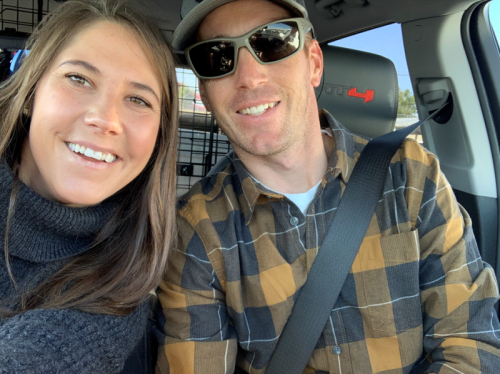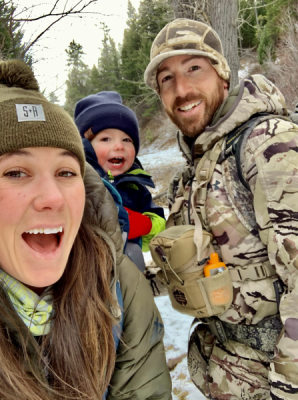On February 16, 2023, Montana Highway Patrol (MHP) Trooper Lewis Johnson was critically injured while pursuing a suspect in the Eureka area. The suspect’s vehicle had become stuck in the snow and Lewis approached him with his weapon drawn in an attempt to apprehend him. The suspect regained control of the vehicle and barrelled right into the responding officer. “It was coming right at me, I didn’t have time to get out of the way,” he recalls. “I don’t remember actually being under the vehicle, but I remember laying in the snow trying to breathe after it happened.” Lewis had been completely run over and was now fighting for his life. His left shoulder and all but two of his ribs were broken, his right lung, liver, and stomach were all in bad shape, and he had a severe spinal injury. Deputy Clint Heintz of the Lincoln County Sheriff’s Office, the other officer involved in the chase, was able to tend to Lewis and began the rescue operation.
 Logan Health’s A.L.E.R.T. helicopter was dispatched while a local ambulance picked up Lewis and brought him to the Eureka Ranger Station. Shortly after, the A.L.E.R.T. team arrived on scene. “We did our initial assessment and found that he was in fairly rough shape,” recalled Leon DeJong, RN, the responding A.L.E.R.T. flight nurse. “We noticed his lower extremities weren’t working properly, and his breathing was diminished on one side.” Lewis was quickly loaded up into the helicopter and administered pain medication. “I’ve never seen anybody in that rough of shape with such a positive attitude,” added Reece Roat, the A.L.E.R.T. flight paramedic on the scene. “He was very focused on what we were doing and what we were saying.” Lewis was then flown to Logan Health Medical Center (LHMC) in Kalispell for emergency treatment.
Logan Health’s A.L.E.R.T. helicopter was dispatched while a local ambulance picked up Lewis and brought him to the Eureka Ranger Station. Shortly after, the A.L.E.R.T. team arrived on scene. “We did our initial assessment and found that he was in fairly rough shape,” recalled Leon DeJong, RN, the responding A.L.E.R.T. flight nurse. “We noticed his lower extremities weren’t working properly, and his breathing was diminished on one side.” Lewis was quickly loaded up into the helicopter and administered pain medication. “I’ve never seen anybody in that rough of shape with such a positive attitude,” added Reece Roat, the A.L.E.R.T. flight paramedic on the scene. “He was very focused on what we were doing and what we were saying.” Lewis was then flown to Logan Health Medical Center (LHMC) in Kalispell for emergency treatment.
The team at LHMC had been notified of the Trooper’s impending arrival and were ready for him when he touched down. “While getting a heads up of incoming patients is relatively standard, there was additional urgency behind this, given the patient’s status as a trooper,” says Bethany Weiler, MD, critical care physician and the nocturnal intensivist on call at the time. “There is a long and deep relationship between law enforcement and health care workers, and a sense of duty to each other in times of crisis, and we especially wanted to ensure that our staff was ready and equipped to deliver excellent care to Trooper Johnson.”
Upon arriving at LHMC, Lewis was brought directly into the emergency department where a multidisciplinary team of medical professionals was waiting for him. Dr. John Craig was just coming off his shift as the on-call trauma surgeon at the time the call came in. “He arrived right during that golden hour where we switch from day shift to night shift,” he recalls. “Dr. [Justine] Gavagan had arrived right before the patient did and she took over as the trauma surgeon. I stuck around to make sure his hemodynamics were okay, but once everything was under control, she took it from there.”
Following the initial evaluations, multiple specialists were called in to tend to Lewis and the various injuries he had. The neuro team quickly brought him in for surgery to stabilize his back for his spinal injury. Later orthopedics addressed a leg fracture they located and the trauma team dealt with the rib fractures, collapsed lung and other organ damage. In an instance like that, structured collaboration is key.
“It’s kind of like a continuous handoff,” adds Dr. Craig. “When there’s 10-12 people sitting in the trauma bay from lab techs, radiology techs, nurses, nursing students, ER docs and trauma surgeons, it’s a busy place. So that handoff has to be pretty fluid. We have an efficient and effective trauma system.”
After surgery, Lewis was transferred to the Intensive Care Unit (ICU), where a multidisciplinary team made up of two neurosurgeons, a critical care physician, a trauma surgeon and an anesthesiologist assembled to discuss their management plan, as well as the patient’s needs going forward. The level of coordination and communication between the group of highly specialized and experienced individuals ultimately ensured the best possible outcome for Lewis.
Meanwhile, Trooper Kate Johnson, Lewis’ wife and a fellow MHP trooper, had heard about the incident and was on-site to be with her husband by the time the ambulance had picked him up. After he was airlifted away, she was driven down to Kalispell to be with him. Law enforcement officers across northwest Montana also began making their way to LHMC to show their support.
 Marsha Lyles, a surgical services lead at LHMC, was working when she heard about the incident with Lewis and knew she needed to be there to meet Kate in the Emergency Department. A few months prior, Marsha’s husband, a lieutenant with the Montana Motor Carrier Services, had a serious heart emergency and Kate was there in the same emergency department to help support her. Now it was her turn to return the favor. In addition to her husband, Marsha’s son is a corrections officer, and her daughter is a MHP Trooper and so she understood the extremity of the situation and knew there was going to be an outpour of supporters on their way too.
Marsha Lyles, a surgical services lead at LHMC, was working when she heard about the incident with Lewis and knew she needed to be there to meet Kate in the Emergency Department. A few months prior, Marsha’s husband, a lieutenant with the Montana Motor Carrier Services, had a serious heart emergency and Kate was there in the same emergency department to help support her. Now it was her turn to return the favor. In addition to her husband, Marsha’s son is a corrections officer, and her daughter is a MHP Trooper and so she understood the extremity of the situation and knew there was going to be an outpour of supporters on their way too.
“Marsha met us at the door when we got there,” Kate recalls. “She stayed with us the entire time. Every medical decision there was, she helped explain it and let us know that we had options. I trusted her and knew we were getting the best possible care.” Marsha’s shift was supposed to end at 5:30 p.m. that day, but she knew she needed to be there to support Kate through the whole process. Because of her connection with local law enforcement, Marsha quickly became the liaison between Lewis and his care team and all the law enforcement supporters who showed up at the hospital. She went back and forth between the surgical area and the waiting room, giving updates as they happened. She estimates that she didn’t get home until about 1 a.m. that next morning. But to her, this was just her way of supporting local law enforcement. “We’re a community who backs the blue, it’s what we do,” she says. Marsha was back early the next morning to continue caring for Kate and all of the other supporters.
After three days on a ventilator, Lewis woke up and was able to speak with his family and supporters. By that time, it had become apparent that he had no feeling below his waist. Doctors had informed him that his T7 vertebrae had been dislocated, and it wasn’t clear on whether or not he’d be able to walk again. However, his care team was prepared to help him through this. “With a new traumatic injury like that, your whole world is turned upside down and you need distractions to take your mind off of it,” says B.J. Corpron, RN, one of the intensive care nurses who helped care for Lewis. B.J. connected with him over their mutual love of the outdoors. “It’s important to find personal connections to patients to relate to them,” he continues. “We were both born and raised in Montana, so we were just a couple of Montana boys talking about hunting and fishing. I told her we’re going to get back out there and get back to doing the things we love.”
To Kate, the emotional care she and Lewis received from the staff was huge. The combined care team made up of physicians, advanced practice providers, nurses, aides, techs and support staff helped make the Johnson family feel very comfortable. “They kept him mentally motivated. They were so calm with him and let him know everything was going to be ok. They took their time and worked with both of us to help us every step of the way,” she recalls.
“Everybody was great,“ says Lewis. “From the doctors and nurses to the people cleaning the room, they all were incredible. I never felt like they were just putting in time. It really felt like they cared.” Logan Health staff even went as far as to offer up their fitness center as a place for Kate to blow off steam and escape during the most stressful times. “This is what we’re here for,” says Dr. Brad Roy, executive director of the Logan Health Medical Fitness Center. “We want to promote physical activity and mental health to meet the needs of families that have that kind of care.”
Lewis remained at Logan Health through February 28, until he was transferred to Craig Hospital in Denver, Colorado. A procession of law enforcement vehicles guided him from LHMC to the A.L.E.R.T. plane at Glacier Park International Airport. At the request of the Johnson family, Reece Roat and Leon DeJong, the flight nurse and flight medic from the rescue, were the nurse and medic for the flight to Colorado. As of Summer 2023, Trooper Johnson continues to progress on his rehabilitation.

